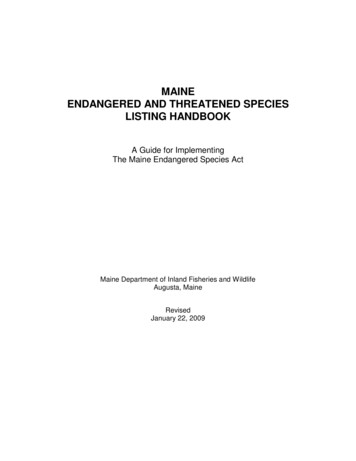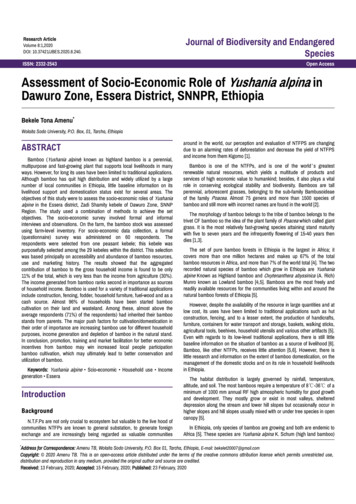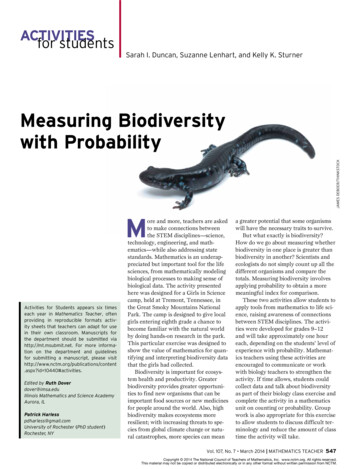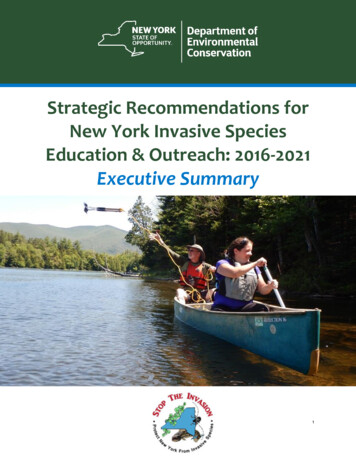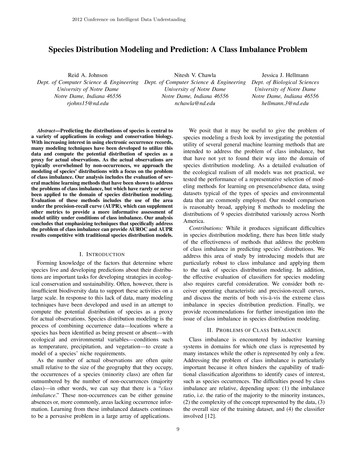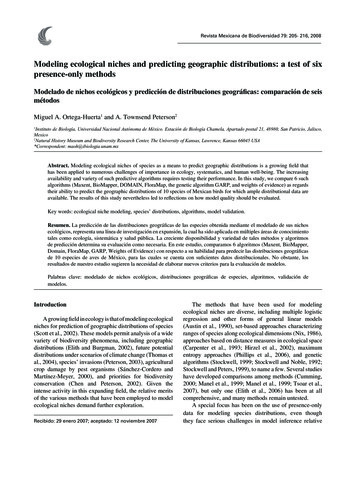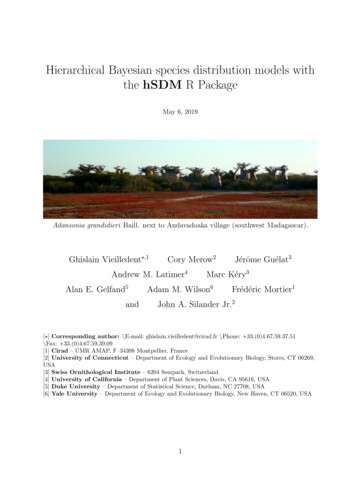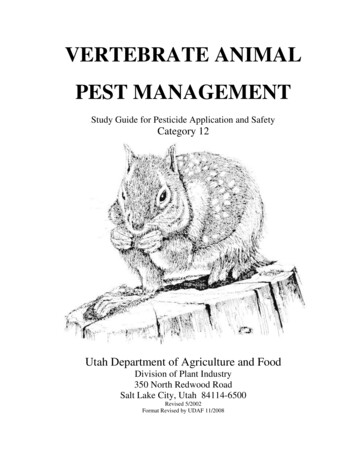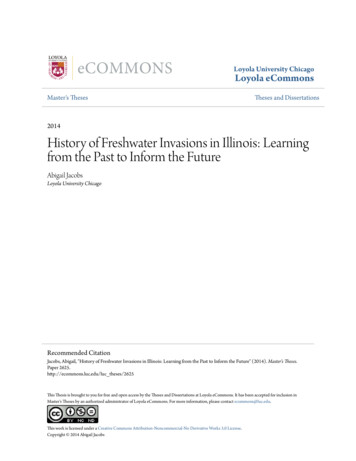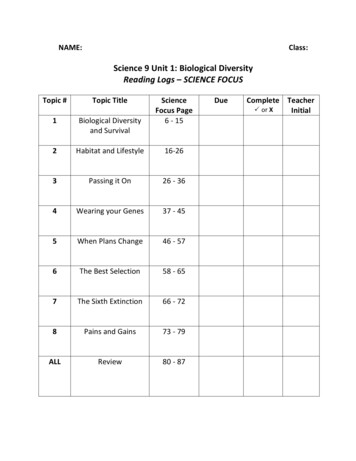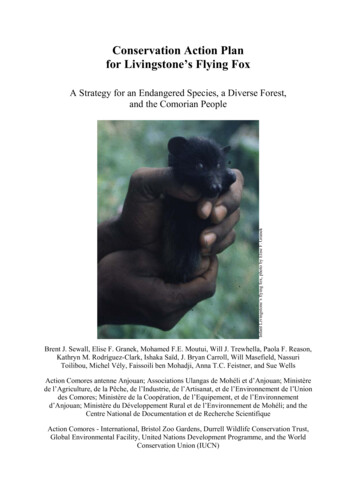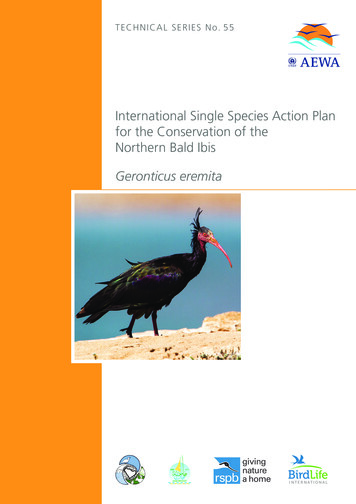
Transcription
TECHNICAL SERIES No. 55International Single Species Action Planfor the Conservation of theNorthern Bald IbisGeronticus eremita
Agreement on the Conservation of African-EurasianMigratory Waterbirds (AEWA)International Single Species Action Planfor the Conservation of the Northern Bald IbisGeronticus eremitaRevision 1AEWA Technical Series No. 55November 2015Produced byThe Royal Society for the Protection of Birds (RSPB), United KingdomBirdLife InternationalPrepared with financial support fromThe Saudi Wildlife Authority (SWA), Saudi ArabiaJazan University, Saudi Arabia
Compiled by: Chris BowdenRoyal Society for the Protection of Birds (RSPB), The Lodge, Sandy, Bedfordshire, SG19 2DL, United KingdomEmail: chris.bowden@rspb.org.ukContributors:Muhannad Abutarab (Syria), Mohammad Al-Salamah (Saudi Arabia), HHP Bandar bin Saud bin MohammadAl-Saud (Saudi Arabia), Ruba Alssarhan (Syria), Nabegh Ghazal Asswad (Syria), Christiane Boehm (InternationalAdvisory Group for the Northern Bald Ibis [IAGNBI] expert), Chris Bowden (Coordinator), Sergey Dereliev(UNEP/AEWA Secretariat), George Eshiamwata (BirdLife Africa),Mihret Ewnetu (Ethiopia), Amina Fellous(IAGNBI Algeria), Johannes Fritz (IAGNBI Austria), Hamida Salhi (Algeria), Jaber Harise (Saudi Arabia), TanerHatipoglu (Turkey), Sureyya Cevat Isfendiyaroglu (Turkey), Sharif Al Jbour (Eastern regional co-coordinator),Mike Jordan (IAGNBI South Africa) Omar Al Khushaim (Saudi Arabia), Nina Mikander (UNEP/AEWASecretariat), Moulay Melliani Khadidja (Algeria), José Manuel López (Spain), Yousuf Mohageb (Yemen),Noaman Mohamed (Morocco), Ammar Momen (Saudi Arabia), Rubén Moreno-Opo (Spain), Widade Oubrou(Morocco), Jorge Fernandez Orueta (Western regional co-coordinator), Lubomir Peske (IAGNBI expert), MiguelAngel Quevedo (IAGNBI Spain), Roger Safford (BirdLife International), Gianluca Serra (IAGNBI expert), RobSheldon (Independent), Mohammed Shobrak (Saudi Arabia), Dawit Tesfai (Eritrea), Zafar Ul Islam (SaudiArabia), Can Yeniyurt (Turkey), Yacob Yohannes (Eritrea), Fehmi Yuksel (Turkey).Milestones in the Production of the Plan:StakeholderWorkshop:First draft:Second draft:Final draft:1st Meeting of the AEWA Northern Bald Ibis International Working Group (NBI IWG),Jazan, Saudi Arabia, 19-22 November 2012Presented to the NBI IWG in October 2014Presented to the AEWA Technical Committee in March 2015, circulated to range states forformal consultation in April 2015 and approved for submission to the 6th Session of the Meetingof the Parties to AEWA (MOP6), by the AEWA Standing Committee in August 2015Adopted by MOP6, Bonn, Germany, 9-14 November 2015Geographical scopeThis International Single Species Action Plan requires implementation in the following countries: Algeria, Eritrea,Ethiopia, Morocco, Saudi Arabia, Syria, Turkey, and Yemen.ReviewsThis International Single Species Action Plan supersedes the previous version adopted at the 3rd Session of theMeeting of the Parties to AEWA, 2005, and should be revised again in 2025. An emergency review shall beundertaken if there are sudden major changes liable to affect the population.Recommended citationBowden, C.G.R. (Compiler) 2015. International Single Species Action Plan for the Conservation of the NorthernBald Ibis (Geronticus eremita). AEWA Technical Series No. 55. Bonn, Germany.Picture on cover: Northern Bald Ibis (Geronticus eremita) Torsten Pröhl.Disclaimer: The designation employed and the presentation of the material in this document do not imply theexpression of any opinion whatsoever on the part of UNEP/AEWA concerning the legal status of any State,territory, city or area, or of its authorities, or concerning the delimitation of their frontiers and boundaries.This International Single Species Action Plan represents a full revision of, and supersedes the 2005 version(AEWA Technical Series No. 10).
AEWA Technical Series No. 55ContentsAbbreviations and Acronyms .4Preface .5Executive Summary .61. Biological Assessment .81.3 Distribution Throughout the Annual Cycle .81.4. Habitat Requirements .111.5. Survival and Productivity .121.6. Population Sizes and Trends .132. Threats .182.1. General Overview .182.2 Critical and High Threats .182.3. Medium Threats .203. Knowledge Needs.234. Policies and Legislation Relevant for Management .244.1. International Conservation and Legal Status of the Species.244.2 National Policies, Legislation and Ongoing Activities .254.3 Site and Habitat Protection .264.4 Recent Conservation Measures and Coordination of Implementation .274.5 The Potential Role for Reintroduction .295. Ongoing Translocation Projects and their Potential Association with the ISSAP .306. Framework for Action .327. Awareness Raising and Communication Work .438. References .44Appendix 1 - AEWA Northern Bald Ibis International Working Group Terms of Reference .47International Single Species Action Plan for the Conservation of the Northern Bald Ibis 3
AEWA Technical Series No. 55Abbreviations and AcronymsBLI/BLMEBirdLife International /BirdLife Middle EastDDDoğa Derneği Nature Society / BirdLife TurkeyHCEFLDHaut Commissariat aux Eaux et Fôrets et à la Lutte contre la DésertificationIAGNBIInternational Advisory Group on the Northern Bald IbisICARDAInternational Centre for Agricultural Research in the Dry Areas – MoroccoMAARMinistry of Agriculture and Agrarian Reform – SyriaISSAPAEWA International Single Species Action PlanSEO/BirdLifeSociedad Española de Ornitología / BirdLife SpainSSCSpecies Survival Commission of the IUCNSSCWSyrian Society for Conservation of WildlifeACSADThe Arab Centre for the Study of Arid Zones and Dry LandsRSPBThe Royal Society for the Protection of BirdsIUCNThe World Conservation UnionNBI IWGAEWA Northern Bald Ibis International Working Group4 International Single Species Action Plan for the Conservation of the Northern Bald Ibis
AEWA Technical Series No. 55PrefaceThe first AEWA International Single Species Action Plan (ISSAP) for the Conservation of the NorthernBald Ibis was approved by the 3rd Session of the Meeting of the Parties to AEWA in 2005. A revisionof this ISSAP led by Mr Chris Bowden (RSPB) commenced at the 1st Meeting of the AEWA NorthernBald Ibis International Working Group (NBI IWG) in November 2012 in Jazan, Saudi Arabia. Theresulting draft was circulated to the Jazan workshop participants in October 2014.The second draft was consulted with the AEWA Technical Committee in March 2015 and was submittedfor formal consultation with the range states in April 2015. The final draft was endorsed by the AEWAStanding Committee in August 2015 and approved by the 6th Session of the Meeting of the Parties toAEWA in November 2015.This revised Action Plan is based on the AEWA International Single Species Action Plan for theConservation of the Northern Bald Ibis1 adopted by the 3rd Meeting of the AEWA Parties in 2005, whichremains an invaluable source of published information on the les/publication/ts10 ssap nbi complete 0.pdfInternational Single Species Action Plan for the Conservation of the Northern Bald Ibis5
AEWA Technical Series No. 55Executive SummaryThe Northern Bald Ibis (Geronticus eremita) is classified as Critically Endangered on the IUCN RedList due to its small range and small population size. The species has undergone a serious decline overa period of hundreds of years, with a particularly sharp downturn recorded since the 1950s, attributed toa combination of habitat loss, DDT pesticide poisoning, direct persecution and disturbance. The mainthreats the species now faces vary in the countries where it still occurs.Once distributed over much of North and North East Africa, central Europe and the Middle East, theNorthern Bald Ibis now remains in two geographically distinct populations, which are also geneticallydistinct: Main western population (W) occurs in Morocco, where the population now numbers 115breeding pairs). Main eastern population (E) the relict population of three pairs rediscovered in 2002 has sincedwindled and by 2013 no breeding pairs apparently persisted in Syria. The wild population couldnow be considered extinct although a few birds still occur in the wintering area. A semi-wildpopulation exists and is now increasing in Turkey, which constitutes a very important geneticresource for a time when reintroduction methodology has been developed further.The main focus of this International Single Species Action Plan is the conservation of these twopopulations. In addition, the Action Plan takes into account released populations being established inthe historic range in Europe (Spain and Austria/Germany/Italy) and how these can develop themethodology needed for future releases within the priority areas.The Northern Bald Ibis currently occurs in eight countries within the AEWA Agreement Area. Theseare referred to as Principle Range States and have the major responsibility for its implementation:Algeria (W)Eritrea (E)Saudi Arabia (E)Turkey (E)Ethiopia (E)Morocco (W)Syria (E)Yemen (E)This plan identifies the key threats to the species as well as the key actions required to improve theconservation status of the Northern Bald Ibis in the Principle Range States. In addition, there have beenincidental but very brief recent occurrences of the species in Jordan, Sudan and Djibouti. These countrieshave, however, not been included in this Action Plan for pragmatic reasons, although this could changefor future updates.The Goal of this Action Plan is to restore the Northern Bald Ibis to a favourable conservation status. Itis aimed to downlist the species from the globally threatened categories on the IUCN Red List and fromColumn A, category 1 of AEWA Table 1.The Purpose is to increase the population size and breeding range of the species. To meet this goal, thefollowing four objectives (to be achieved by 2025) are set out in the plan:6 International Single Species Action Plan for the Conservation of the Northern Bald Ibis
AEWA Technical Series No. 55Objective 1: Increase reproduction successObjective 2: Reduce adult/juvenile mortalityObjective 3: Establish new coloniesObjective 4: Fill key knowledge gapsThe plan also identifies Results and Actions through which each objectives is to be delivered.This plan covers the period 2016 to 2025. A revision should be undertaken in 2025. However, anemergency review can be undertaken prior to 2025 if there are any sudden major changes liable to effecteither population.The implementation of the plan will be coordinated and reviewed by the inter-governmental AEWANorthern Bald Ibis International Working Group which is open to all range states and relevantstakeholder organisations.International Single Species Action Plan for the Conservation of the Northern Bald Ibis7
AEWA Technical Series No. 551. Biological Assessment1.1. General InformationThe Northern Bald Ibis or Waldrapp Ibis (Geronticus eremita) is about 70-80 cm long and weighs 1,0001,500 g. The body is elongated with a fairly long neck. The legs are fairly long and brownish red. Headand throat are naked and deep red. The nape feathers are elongated. Juvenile birds up to two years havefeathers on head and neck, which are greyish-brown and shorter than in adults.1.2. Taxonomy and Biogeographic PopulationsPhylum: ChordataClass: AvesOrder: CiconiiformesSuborder: CiconiaeFamily: ThreskiornithidaeSubfamily: ThreskiornithinaeGenus: GeronticusSpecies: Geronticus eremita L. 1758The Northern Bald Ibis is a monotypic species with two genetically distinct populations having just onecongeneric species in southern Africa, Southern Bald Ibis Geronticus calvus. The main Westernpopulation in Morocco is maintaining a relatively stable if still precariously small population, whilst forthe Eastern population the situation has deteriorated further towards the brink of extinction. Meanwhilethere has been significant progress over the past ten years with captive and semi-wild reintroductiontrials which are showing new potential for re-establishing populations within the former range.Although there are no major morphological distinctions between the eastern and western populations,there is evidence (Pegoraro et al. 2001, Broderick et al. 2001) of a genetic distinction between them,and it should be noted that the majority of the very substantial captive population, including the birdsused for releases in Europe, are of Western (Moroccan) origin. A comprehensive genetic study isunderway.1.3 Distribution Throughout the Annual CycleBreeding for both Eastern and Western populations takes place from late February until early June, withegg laying from late March into April. In the non-breeding season, the eastern adult population remainsin highland grassland habitats of unintensive agriculture in Ethiopia, whilst sub-adults (at least in recenttimes) apparently spend this time wandering within the Arabian Peninsula (Saudi Arabia and Yemen)and it is possible that some may even linger further north.The remaining Western population shows some signs of dispersing south within Morocco, especiallyduring the two months immediately following the breeding season. Although it is possible that a fewmay still venture outside Morocco as early records show was formerly the case, the vast majoritycertainly remain in Morocco in relatively close proximity to the two coastal breeding sites near Agadir.8 International Single Species Action Plan for the Conservation of the Northern Bald Ibis
AEWA Technical Series No. 551.3.1. Eastern populationSatellite tagging of birds in Syria has helped map the migration route for the Eastern population (Lindsellet al. 2009 Figure 1) and how the birds move very quickly south in June and July, spending a few weeksin Saudi Arabia and Yemen, before crossing the Red Sea to the Ethiopian highlands in August. Juvenileand sub-adult birds appear to stop off along the same route and although information is less wellsubstantiated, it appears that some may even remain further north, which may mean they are moreexposed to higher mortality risks including illegal hunting (Serra et al. 2014). It should be noted thatJordan, Eritrea and Sudan also regularly host the migrating birds but only very briefly.Figure 1. Migratory route of the Eastern population as it was discovered in 2006 through satellitetelemetry. Autumn southward journey to the east, spring northward journey to the west, each of thembeing about 3,200 km long. (map from Lindsell et al. 2009)1.3.2. Western populationThe Western population breeds at two main sites in Morocco. Observations and preliminary taggingwork has shown that birds from the Western population (in Morocco) regularly interchange between thetwo Moroccan breeding sites during the non-breeding period, but knowledge of juvenile post-breedingperiod dispersal is not yet fully understood. However, a limited number of birds do move hundreds ofkilometres to the south along the coast.International Single Species Action Plan for the Conservation of the Northern Bald Ibis9
AEWA Technical Series No. 55By February, most of the birds including immature individuals and non-breeding sub-adults visit thebreeding sites, and the breeding populations mainly forage within 25 km of the two main breeding sitesusing the steppe and un-intensive agricultural habitats within Souss-Massa National Park and the Tamriarea just 100km to the north (Bowden et al. 2003).Outside the breeding season, the majority of birds still feed and roost within the boundaries of theNational Park and within 20 km of Tamri (Figure 2 below from Bowden et al. 2003). Historical recordsstrongly suggest that the now extinct populations from further north in Morocco (primarily Atlas andMiddle Atlas ranges), and very probably including the small former population in Algeria, were moremigratory than the two remaining colonies, and regularly wintered further south in Morocco and evenas far as Mauritania and Mali. Recent studies in Europe involving descendants from the Moroccan Atlaspopulations, indicate that these birds are able to adapt to a migratory lifestyle (Portugal et al. 2014;Voelkl et al. (in prep.); Bairlein et al. (in prep.).Figure 2. The two remaining Western population colonies in Morocco occur in Souss-Massa nationalPark and in the region of Tamri. (map from Bowden et al. 2003)10 International Single Species Action Plan for the Conservation of the Northern Bald Ibis
AEWA Technical Series No. 551.4. Habitat Requirements1.4.1 Breeding habitat selection and useThe general habitat of the Northern Bald Ibis during the breeding season is the combination of availablecliff nesting sites in sufficiently close proximity to large areas of feeding habitat. This usually consistsof semi-arid and rocky plains, but in close proximity (less than 15-20 km) to cultivated land, steppe andmeadows which it uses to forage. It is a colonial breeder and the nests of loosely constructed twigs andvegetation are placed on cliff ledges at least one-metre-wide which may be sea or large river cliffs andoccasionally, even large buildings. It will also use artificial ledges.However, the height, size and shape of the ledges are all important in terms of safety from predators andother disturbance and also the aspect and the amount of shade provided (Pegoraro 1996). The remainingpopulation in Morocco exclusively uses sea cliffs, (Bowden et al. 2003) whilst that in Syria useslimestone rock faces (Serra et al. 2009) – all of which are extremely difficult for humans to access. Thesemi-wild population in Turkey occupies mainly artificial nest boxes as well as some provided rockplatforms and a small minority nests on natural rock faces and caverns.1.4.2 Feeding habitat selection and use including at stopover sitesThe diet of the Northern Bald Ibis includes any available animal life including insects, spiders,scorpions, earthworms, snails and vertebrates such as fish, amphibians, lizards and snakes (Aghnajet al. 2001, Serra et al. 2008), and even occasional small rodents and birds. It will also feed on vegetationincluding berries, shoots, duckweed, and rhizomes of aquatic plants (Hancock et al. 1992).Feeding areas in Morocco are primarily littoral steppe, fallow areas of cultivation, and occasionallyactive but un-intensively cultivated areas. Feeding areas in Syria are not dissimilar, but somewhatinferior, usually in undulating and degraded steppe with sparse dwarf shrubland within a large drainagebasin of mountain ranges (providing sheer cliffs for nesting). Probably due to the advanced degree ofdegradation of the original feeding habitats, birds rely on temporary abundance of young toads living inhuman-made artificial reservoirs (Serra et al. 2008).The altitude of the feeding areas increases through the season from spring to the summer months (Serraet al. 2008). The substrate of feeding areas varies enormously between soft mobile sand, through a fullrange of other substrates to almost entirely rocky areas if there is a temporary abundance of prey in thearea, but these are all open terrain areas. Free flying birds in Central Europe almost exclusively usemeadows and pastures as feeding areas (Fritz & Unsöld 2011). The birds need sufficient visibility toavoid approaching predators and also sufficiently open spaces to allow their characteristic (often fastwalking) foraging style, which is mainly tactile by probing within soft substrate, preferably soil andsand. But they are also able to hunt using optical cues on and above the substrate surface.Feeding areas during the breeding season in Morocco were always within 26 km of the nesting sites, butmost areas were less than half that distance (Bowden et al. 2003). It is important that the vegetation iseither sparse and open (semi-arid areas) or not taller than 10 to 15 cm (meadows and pasture). Changesin vegetation structure and in cultivation may lead to quick abandonment of feeding areas and nestinggrounds (Hirsch pers. comm.)International Single Species Action Plan for the Conservation of the Northern Bald Ibis11
AEWA Technical Series No. 55Little is known about the use of habitats whilst birds are on migration, although satellite tracking andsurveys in the field have shown that, in addition to open arid habitats, they also use recent or activecultivations (Serra et al. 2010). GPS tracking data from the released European birds indicate that duringmigration, they use habitats with similar characteristics to those in the breeding area, ie mainly meadowsand pastures with low vegetation.The scarcity of trees and cliffs along the Eastern migration route means that tall human-made objectsincluding electricity pylons are often used for roosting and these present their own hazards as wasdemonstrated in Jordan when there was an electrocution incident of at least three birds (Serra et al.2014). Also for the released European birds, electrocution along the migration route is a major cause ofmortality (Fritz & Unsöld 2013). In Turkey, the semi-wild population frequently forages in thesurrounding areas despite the food provisioning there. Areas used include a large tree nursery,agricultural fields, margins of the Euphrates River and areas of grassland steppe.1.4.3. Winter habitat selection and useIn the main Moroccan breeding areas, the winter distribution is largely similar to that during the breedingseason. There are some seasonal variations and areas of littoral steppe still within the Souss-MassaNational Park, which are used more extensively outside the breeding season, as are some otherwise moreheavily disturbed and unprotected areas north of Agadir.For the Eastern population, satellite tracking has uncovered the main wintering grounds and the majorityof the relict population has consistently returned to a very restricted area in highland Ethiopia. The birdsutilise wet and dry pastures, including recently cut hayfields, in an area where human disturbance is low,but it is also notable that there is no evidence of any hunting pressures. Repeated visits have shown thatthe birds consistently use the same areas (mostly just 9 km2) and utilise tall trees for roosting (Serraet al. 2013).1.5. Survival and Productivity1.5.1.Nest survival and causes of nest lossThe nest is a loose construction of twigs lined with smaller sticks, grass or straw. Eggs are very paleblue and weigh on average 50.1g. Clutch size averages around three but regularly varies between oneand five. Incubation is 24-28 days, and the fledging period 40-50 days. The time to full independencevaries between individuals, but is usually about two months. Both parents incubate and feed the chicks.The age of maturity is three years (in captivity), but apparently, in some cases, even longer in the wild(Hirsch 1979).At the Moroccan colonies, 9.1% of clutches were lost during incubation and these were attributed tonest destruction by other ibis individuals and Common Ravens (Corvus corax) although there was alsoevidence of nocturnal predation, possibly by Pharaoh Eagle Owl (Bubo ascalaphus) and for the majorityof such clutches, they simply went missing with no known cause (Bowden et al. 2008). Limited Syrianinformation shows similar trends and causes (Serra et al. 2009a & 2011). Clearly in the absence ofwardening, human disturbance and predation has also been a major factor as wardens have preventedpotentially serious disturbance and predation events both in Morocco and Syria (Bowden et al. 2008,Serra et al. 2009a & b).12 International Single Species Action Plan for the Conservation of the Northern Bald Ibis
AEWA Technical Series No. 55Failed clutches are only replaced by relaying eggs, if the failure happens early in the season, and chicksurvival is much more variable and apparently mainly related to climatic conditions and resulting foodavailability (see below). It was demonstrated that chick survival can be significantly improved byprovision of a regular nearby water source (Smith et al. 2009).1.5.2.Productivity and annual survivalBetween 1994 and 2004, the reproduction rate per breeding pair has varied from 0.6 to 1.6 fledgedchicks in Morocco (El Bekkay et al. 2003). Circumstances, such as time spent away from the nest whenthe chicks are young, may have the biggest influence in the reproductive success, which is largelyinfluenced by the proximity of feeding areas and recent climatic conditions (especially rainfall),affecting food availability, particularly the abundance of invertebrates. (Bowden et al. 2003, Smithet al. 2009). Intensive round-the-clock protection was certainly a factor in the production in Syria duringthe period 2002-2004, which was 1.75 chick per nest (Serra et al. 2009).The Northern Bald Ibis is a long-lived species. In captivity, birds reach an average of 20-25 years (oldestmale 37 years, oldest female 30 years (Boehm 1999). Reproduction takes place when birds are two yearsold, however normally only if they have an experienced older partner. Many birds only start breeding at3-5 years. Breeding is possible until the age of 26-28, even if a bird has never bred before. However, thepeak breeding age is between 8-15 years for both sexes.Satellite tracking revealed a particularly high mortality rate for immature birds during migration fromthe Syrian colony (Serra et al. 2014) and it was suggested - despite the inevitably small sample - thatthis may be driving the overall decline of that population.1.6. Population Sizes and TrendsSince the beginning of the 20th century and even earlier, there have been sharp declines of both theWestern and Eastern populations.1.6.1.Eastern populationFormer records tell of thousands of birds (19th century, Danford 1880, Kummerloeve 1962); 3000 birdsin Birecik in1930, down to 400 in 1982, five pairs in 1986, seven in 1987 and one left in 1989 (Akcakaya1990). The wild colony was declared extinct in 1992 (Akcakaya et al. 1992). The main cause of declinewas the use of pesticides (DDT) and human disturbance in Turkey, and hunting in Syria and when onmigration further south in Arabia.In 2002 there was the discovery of a relict colony in Syria, with seven birds comprising three activelybreeding pairs (Serra et al. 2004). By 2012 however, only three birds returned from migration in spring,and although there was one welcome addition soon after, making a total of four, just the one pair laideggs but failed to rear any young. No reinforcement was possible using Turkish birds that year, whichwas a great pity as failed trial releases in 2011 had shown some very promising signs that thismethodology could succeed, with the released birds joining the wild ones on migration as far as southernSaudi Arabia (Bowden et al. 2011).Unfortunately, there have not been any breeding pairs subsequently recorded, despite four birds beingseen at the regular Ethiopian wintering site, just one adult female returning in both 2013 and 2014(www.iagnbi.org). The wild population appears therefore to be on the very brink of extinction.International Single Species Action Plan for the Conservation of the Northern Bald Ibis13
AEWA Technical Series No. 551.6.2.Western populationThe number of colonies in Morocco and Algeria has sharply declined since the early 20th century. Thelast colony in Algeria disappeared in the late 1980s. In Morocco, in 1940 there were still about 38colonies, in 1975, 15 and in 1989 only 3 colonies survived. Reasons for the decline were a combinationof human disturbance, hunting and the use of pesticides (Collar & Stuart 1985). Since the late 1990s thepopulation in Souss Massa NP has been stable and since 1999 increasing (Status in 2012 -105 breedingpairs increasing to a recent high of 115 in 2014 (Oubrou & E
The first AEWA International Single Species Action Plan (ISSAP) for the Conservation of the Northern Bald Ibis was approved by the 3rd Session of the Meeting of the Parties to AEWA in 2005. A revision of this ISSAP led by Mr Chris Bowden (RSPB) commenced at the 1st Meeting of the AEWA Northern
